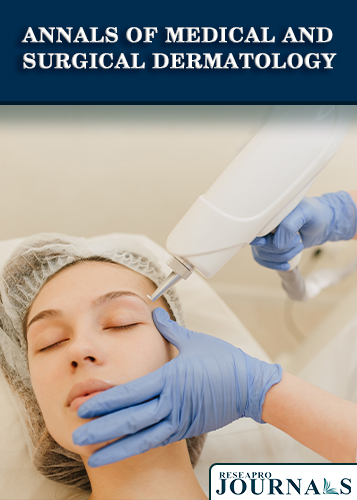
Annals of Medical and Surgical Dermatology
OPEN ACCESS
ISSN: 3048-5193

OPEN ACCESS
ISSN: 3048-5193

Background: Hidradenitis suppurative (HS) is a chronic inflammatory skin condition. The protracted and recurrent nature of the illness has serious physical and psychological repercussions for the unfortunate sufferers. Public awareness and understanding about the course and likely outcome would help to improve the overall outcome of management. The current study was conducted to determine the clinical presentation and management outcome of HS with a standard trimodal therapeutic approach.
Methods: This descriptive study was carried out at the National Institute of Rehabilitation Medicine, Islamabad, over a period of seven years. All patients who presented with HS during the study period were included. Non–consenting patients were excluded.
Results: Out of 31 patients, there were 22 males (70.96%) and 9 females (29.03%). The age range was 12-41 years, with a mean age of 27.93 ± 6.73 years. 90.32% of them were adults. The anatomic locales most commonly affected were the axillae (n=31; 100%), groins (n=9; 29.03%), and buttocks (n=5; 16.12%). 17 (54.83%) patients had stage III disease, whereas 8 (25.80%) patients had stage I disease, and 6 (19.35%) patients had stage II disease. Family history of HS was positive among 4 (12.90%) patients. The most common comorbidities identified included obesity (n=9; 29.03%), hypertension (n=2; 6.45%), and polycystic ovarian syndrome (PCOS) (n=2; 6.45%). The various surgical interventions instituted included incision and drainage (n=7; 22.58%), surgical deroofing (n=4; 12.90%), wide local excisions and reconstruction with skin grafts or local pedicled flaps (n=19; 61.29%). There was no local recurrence at two years following the radical excision and reconstruction; however, the emergence of new HS lesions at other sites was observed among 17.64% of these patients.
Conclusion: In the studied population, the disease was found to be significantly more prevalent among adult males. The majority of them had stage III disease. The most common associated comorbidities were obesity, hypertension, and PCOS. The majority of the patients were successfully managed with wide local excisions and reconstruction with skin grafts or local pedicled flaps.